Dislocated Shoulder
Updated:
(Also known as Shoulder Dislocation, Anterior Shoulder Dislocation, Dislocation of the Shoulder Joint)
What is a dislocated shoulder?
A dislocated shoulder is a common traumatic sporting injury characterized by tearing of the connective tissue surrounding the shoulder joint with subsequent displacement of the bones forming the joint so they are no longer situated next to each other (i.e. the upper arm bone comes out of the socket).
The shoulder joint is a ball and socket joint. The shoulder blade gives rise to the socket of the shoulder, whilst the ball of the shoulder arises from the top of the humerus (upper arm bone). Surrounding the ball and socket joint is strong connective tissue holding the bones together known as the shoulder joint capsule (figure 1). In addition, the shoulder joint ligaments (glenohumeral ligaments) help reinforce the joint capsule and a group of muscles known as the rotator cuff cross the shoulder joint and actively help to hold the shoulder joint in position increasing the shoulder’s stability.

During certain movements of the arm, stretching forces are applied to the shoulder joint capsule. When these forces are excessive and beyond what the shoulder can withstand, tearing of the connective tissue may occur. This may allow the upper arm bone (humerus) to move out of the socket if the forces involved are too great and beyond what the connective tissue and supporting muscles can withstand. When this occurs, the condition is known as a dislocated shoulder.
Dislocated shoulders are commonly seen in contact sports such as rugby or Australian rules football, high velocity sports, such as downhill skiing, snowboarding, skateboarding, or in competitive overhead sports such as basketball or water polo.
Causes of a dislocated shoulder
A dislocated shoulder typically occurs traumatically due to forces pushing the ball shaped aspect of the upper arm bone out of the socket. This may occur due to a direct impact or more commonly, due to a fall on the outstretched arm. The usual movements involved in this injury are a combination of shoulder abduction (side elevation) and excessive external rotation (outer rotation of the humerus) (figure 2). This is often combined with a force to the back of the shoulder or front of the elbow (or both). The result is most commonly an anterior shoulder dislocation (the ball moving forwards out of the socket). Other shoulder movements, positions or external forces, however, can result in an inferior or posterior dislocation of the shoulder (i.e. the ball moving below or backwards out of the socket), however, these tend to be less common.
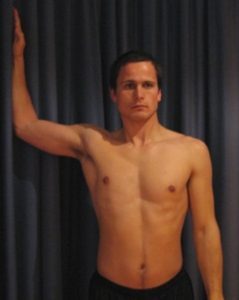
Occasionally, a dislocated shoulder may occur with a relatively trivial movement (such as sneezing or turning over in bed) in these cases, there is usually a history of previous traumatic shoulder dislocation, shoulder instability or generalized ligamentous laxity throughout the body.
Signs and symptoms of a dislocated shoulder
Patients with a dislocated shoulder usually experience sudden severe pain at the time of injury. The pain is usually so intense that the patient cannot continue activity and will often cradle the arm against their body. Pain is usually felt in the shoulder region, however, can occasionally radiate down the arm.
Patients will often experience a sensation of the shoulder ‘popping out’ at the time of injury. Visible deformity of the shoulder joint may also be detected when compared to the other side. Occasionally, patients may experience pins and needles or numbness in the shoulder, arm or hand.
Once a dislocated shoulder has been ‘relocated’ (i.e. the ball positioned back in the socket by a sports medicine professional), patients may experience a feeling of weakness in the shoulder and an ache that may increase to a sharper pain with certain movements. These symptoms generally resolve over time with appropriate rehabilitation. However, patients with this condition may be left with a feeling of impending dislocation when the shoulder is placed in certain positions, particularly the combination of abduction and external rotation (figure 2).
Diagnosis of a dislocated shoulder
A thorough subjective and objective examination from a physiotherapist is usually sufficient to diagnose a dislocated shoulder. X-ray investigation is usually required to determine if there are any fractures associated with the dislocation and to confirm diagnosis. Further investigations such as a CT scan, Ultrasound or MRI may be required to assist diagnosis and determine involvement of other structures.
Treatment for a dislocated shoulder

Members Only ContentBecome a PhysioAdvisor Member to gain full access to this exclusive content. For more details see Become a Member. Already a member? Login Now
Prognosis of a dislocated shoulder
Many patients with a dislocated shoulder heal well with appropriate physiotherapy and return to normal function. This may take weeks to months to achieve an optimal outcome. However, due to the severity of injury and widespread connective tissue damage associated with this condition, patients may experience long term effects. The most common long term effect of a dislocated shoulder is an increased likelihood of future dislocation or subluxation (partial dislocation) with relatively minor trauma. In cases of recurrent shoulder dislocation, surgical repair of the shoulder joint capsule may be indicated. This is usually followed by an extensive rehabilitation program lasting many months.
Patients with a dislocated shoulder who also have damage to other structures such as cartilage, bone or nerves are likely to have a significantly extended rehabilitation period to gain optimum function.
Contributing factors to the development of a dislocated shoulder
There are several factors which can predispose patients to dislocating their shoulder. These need to be assessed and where possible, corrected with direction from a physiotherapist. Some of these factors may include:
- history of previous shoulder dislocation or shoulder instability
- inadequate rehabilitation following a shoulder dislocation
- participation in sports or activities placing the shoulder at risk of dislocation
- shoulder joint hypermobility
- general ligamentous laxity
- shoulder weakness (particularly of the scapular stabilizers and rotator cuff)
- muscle imbalances
- poor posture
- abnormal biomechanics or sporting technique (such as poor throwing technique or faulty swimming style)
- poor core stability
- inappropriate training or technique
- change in training conditions
- fatigue
- inadequate warm up
Physiotherapy for a dislocated shoulder
Physiotherapy treatment for a dislocated shoulder is vital to hasten the healing process and ensure an optimal outcome. Treatment may comprise:
- use of a sling (for pain relief)
- soft tissue massage
- protective shoulder taping
- joint mobilization (thoracic spine or neck)
- dry needling
- ice or heat treatment
- electrotherapy (e.g. ultrasound, TENS)
- progressive exercises to improve rotator cuff strength, shoulder blade stability, shoulder strength, flexibility, posture and core stability
- hydrotherapy
- education
- activity modification advice
- postural correction
- anti-inflammatory advice
- biomechanical correction (e.g. correction of throwing technique, swimming stroke, tennis serve, weight lifting technique etc.)
- devising and monitoring a return to activity plan
Other intervention for a dislocated shoulder
Despite appropriate physiotherapy management, some patients with this condition require other intervention to ensure an optimal outcome. The treating physiotherapist or doctor can advise on the best course of management when this is the case. This may include further investigations such as X-rays, ultrasound, CT scan or MRI, pharmaceutical intervention, corticosteroid injection, or referral to appropriate medical authorities who can advise on any intervention that may be appropriate to improve the condition. Occasionally, patients may require surgery to repair the torn connective tissue or to correct other abnormalities associated with the dislocated shoulder (such as fractures).
Exercises for a dislocated shoulder
The following exercises are commonly prescribed to patients with a dislocated shoulder. You should discuss the suitability of these exercises with your physiotherapist prior to beginning them.
Your physiotherapist can advise when it is appropriate to begin the initial exercises and eventually progress to the intermediate and advanced exercises. As a general rule, addition of exercises or progression to more advanced exercises should take place provided there is no increase in symptoms.
Initial Exercises
Generally, the initial exercises should be performed 3 times daily and only provided they do not cause or increase symptoms.
Pendular Exercises
Begin this exercise by leaning forwards with your unaffected arm supported on a table or bench (figure 3). Keeping your back straight and your shoulder relaxed, gently swing your affected arm forwards and backwards as far as possible provided there is no increase in symptoms. Repeat 10 times. Repeat the exercise swinging your arm side to side as far as possible provided there is no increase in symptoms.
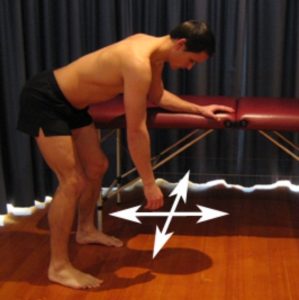
Pendular Circles
Begin this exercise by leaning forwards with your unaffected arm supported on a table or bench (figure 4). Keeping your back straight and your shoulder relaxed, gently swing your affected arm in circles clockwise as far as possible without increasing symptoms. Repeat the exercise swinging your arm counter clockwise. Repeat 10 times in each direction provided there is no increase in symptoms.
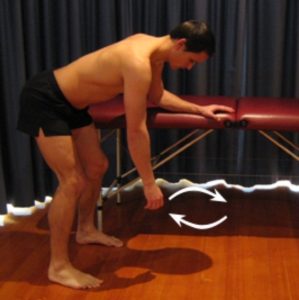
Shoulder Blade Squeezes
Begin this exercise standing or sitting with your back straight (figure 5). Your chin should be tucked in slightly and your shoulders should be back slightly. Slowly squeeze your shoulder blades together as hard and far as possible provided it does not cause or increase symptoms. Hold for 5 seconds and repeat 10 times provided the exercise is pain free.

More Initial Exercises

Members Only ContentBecome a PhysioAdvisor Member to gain full access to this exclusive content. For more details see Become a Member. Already a member? Login Now
Intermediate Exercises

Members Only ContentBecome a PhysioAdvisor Member to gain full access to this exclusive content. For more details see Become a Member. Already a member? Login Now
Advanced Exercises

Members Only ContentBecome a PhysioAdvisor Member to gain full access to this exclusive content. For more details see Become a Member. Already a member? Login Now
Other Exercises

Members Only ContentBecome a PhysioAdvisor Member to gain full access to this exclusive content. For more details see Become a Member. Already a member? Login Now
Rehabilitation Protocol for a Dislocated Shoulder

Members Only ContentBecome a PhysioAdvisor Member to gain full access to this exclusive content. For more details see Become a Member. Already a member? Login Now
 Find a Physio for a dislocated shoulder
Find a Physio for a dislocated shoulder
Find a physiotherapist in your local area who can treat a shoulder dislocation.
 Physiotherapy products for a dislocated shoulder
Physiotherapy products for a dislocated shoulder
Some of the most commonly recommended products by physiotherapists to hasten healing and speed recovery in patients with a dislocated shoulder include:
-
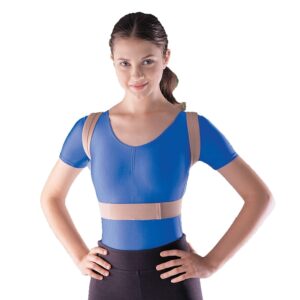 OPPO – Posture Aid / Clavicle Brace (OPP2075)
OPPO – Posture Aid / Clavicle Brace (OPP2075) -
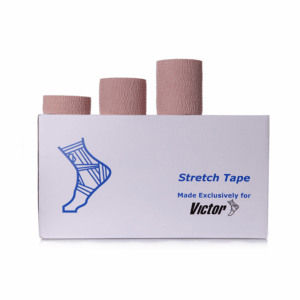 Elastic Adhesive Bandage (Sportstek Victor Stretch Tape)
Elastic Adhesive Bandage (Sportstek Victor Stretch Tape) -
 AllCare Band
AllCare Band -
 Oppo Humerus Brace (OPP4072)
Oppo Humerus Brace (OPP4072) -
 Premium Strapping Tape 38mm (Victor)
Premium Strapping Tape 38mm (Victor) -
 AllCare Tubing
AllCare Tubing -
 AllCare Spikey Massage Ball
AllCare Spikey Massage Ball -
 Fixomull Stretch 5cm x 10m
Fixomull Stretch 5cm x 10m -
 AllCare Instant Cold Pack (15 x 25cm)
AllCare Instant Cold Pack (15 x 25cm) -
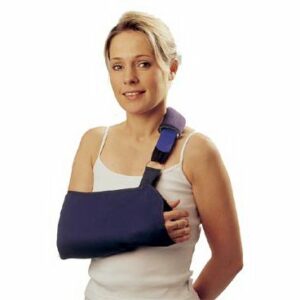 Actimove Arm Sling (Mitella)
Actimove Arm Sling (Mitella)
To purchase physiotherapy products for a dislocated shoulder click on one of the above links or visit the PhysioAdvisor Shop.
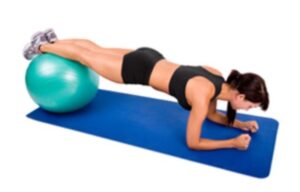 More Exercises
More Exercises
- Shoulder Strengthening Exercises.
- Scapula Stability Exercises.
- Rotator Cuff Strengthening Exercises.
- Upper Body Machine Weights.
- Cable Exercises (Chest & Shoulders).
- Cable Exercises (Back & Biceps).
- Free Weights (Chest & Shoulders).
- Free Weights (Back & Biceps).
- Shoulder Stretches.
- Arm Strengthening Exercises.
- Cardiovascular Exercise.
 More Information
More Information
- Read about Shoulder Taping.
- Read about Postural Taping.
- Read about improving your Posture.
- View detailed information on when to use Ice or Heat.
- View detailed information on initial injury management and the R.I.C.E. Regime.
- View detailed information on Returning to Sport.
- View detailed information on Injury Prevention.
- View our Shoulder Diagnosis Guide.
Become a PhysioAdvisor Member

Link to this Page
If you would like to link to this article on your website, simply copy the code below and add it to your page:
<a href="https://physioadvisor.com.au/injuries/shoulder/dislocated-shoulder”>Dislocated Shoulder – PhysioAdvisor.com</a><br/>Dislocated shoulder causes, symptoms, diagnosis, treatment, exercises, rehabilitation protocol, physiotherapy products and more at Physioadvisor.com.au
Return to the top of Dislocated Shoulder.


